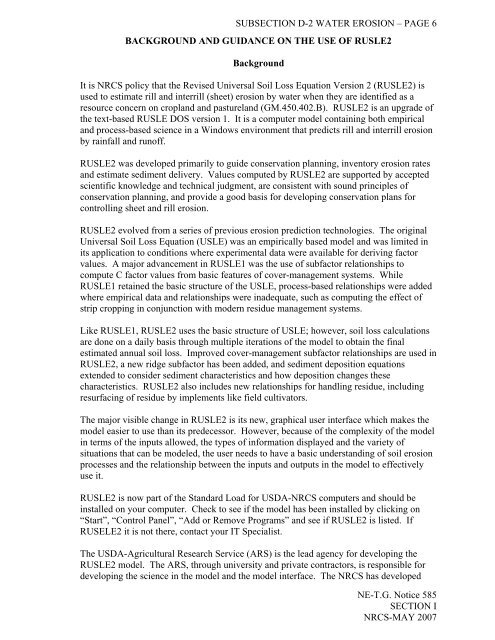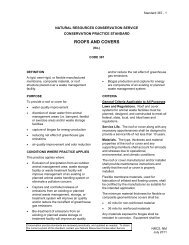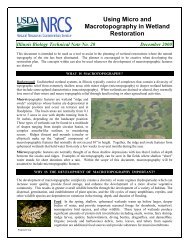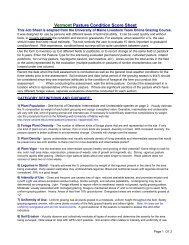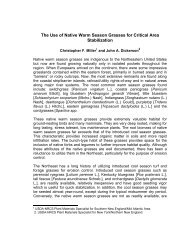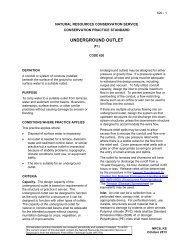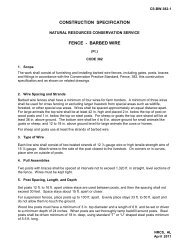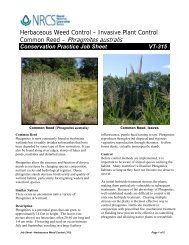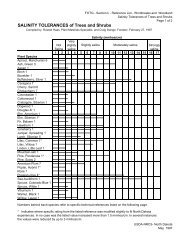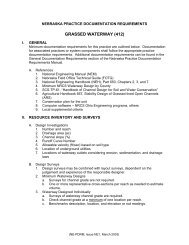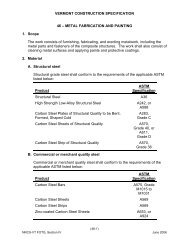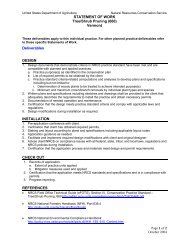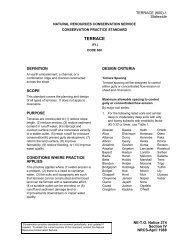estimating sheet and rill erosion - Field Office Technical Guide
estimating sheet and rill erosion - Field Office Technical Guide
estimating sheet and rill erosion - Field Office Technical Guide
Create successful ePaper yourself
Turn your PDF publications into a flip-book with our unique Google optimized e-Paper software.
SUBSECTION D-2 WATER EROSION – PAGE 6<br />
BACKGROUND AND GUIDANCE ON THE USE OF RUSLE2<br />
Background<br />
It is NRCS policy that the Revised Universal Soil Loss Equation Version 2 (RUSLE2) is<br />
used to estimate <strong>rill</strong> <strong>and</strong> inter<strong>rill</strong> (<strong>sheet</strong>) <strong>erosion</strong> by water when they are identified as a<br />
resource concern on cropl<strong>and</strong> <strong>and</strong> pasturel<strong>and</strong> (GM.450.402.B). RUSLE2 is an upgrade of<br />
the text-based RUSLE DOS version 1. It is a computer model containing both empirical<br />
<strong>and</strong> process-based science in a Windows environment that predicts <strong>rill</strong> <strong>and</strong> inter<strong>rill</strong> <strong>erosion</strong><br />
by rainfall <strong>and</strong> runoff.<br />
RUSLE2 was developed primarily to guide conservation planning, inventory <strong>erosion</strong> rates<br />
<strong>and</strong> estimate sediment delivery. Values computed by RUSLE2 are supported by accepted<br />
scientific knowledge <strong>and</strong> technical judgment, are consistent with sound principles of<br />
conservation planning, <strong>and</strong> provide a good basis for developing conservation plans for<br />
controlling <strong>sheet</strong> <strong>and</strong> <strong>rill</strong> <strong>erosion</strong>.<br />
RUSLE2 evolved from a series of previous <strong>erosion</strong> prediction technologies. The original<br />
Universal Soil Loss Equation (USLE) was an empirically based model <strong>and</strong> was limited in<br />
its application to conditions where experimental data were available for deriving factor<br />
values. A major advancement in RUSLE1 was the use of subfactor relationships to<br />
compute C factor values from basic features of cover-management systems. While<br />
RUSLE1 retained the basic structure of the USLE, process-based relationships were added<br />
where empirical data <strong>and</strong> relationships were inadequate, such as computing the effect of<br />
strip cropping in conjunction with modern residue management systems.<br />
Like RUSLE1, RUSLE2 uses the basic structure of USLE; however, soil loss calculations<br />
are done on a daily basis through multiple iterations of the model to obtain the final<br />
estimated annual soil loss. Improved cover-management subfactor relationships are used in<br />
RUSLE2, a new ridge subfactor has been added, <strong>and</strong> sediment deposition equations<br />
extended to consider sediment characteristics <strong>and</strong> how deposition changes these<br />
characteristics. RUSLE2 also includes new relationships for h<strong>and</strong>ling residue, including<br />
resurfacing of residue by implements like field cultivators.<br />
The major visible change in RUSLE2 is its new, graphical user interface which makes the<br />
model easier to use than its predecessor. However, because of the complexity of the model<br />
in terms of the inputs allowed, the types of information displayed <strong>and</strong> the variety of<br />
situations that can be modeled, the user needs to have a basic underst<strong>and</strong>ing of soil <strong>erosion</strong><br />
processes <strong>and</strong> the relationship between the inputs <strong>and</strong> outputs in the model to effectively<br />
use it.<br />
RUSLE2 is now part of the St<strong>and</strong>ard Load for USDA-NRCS computers <strong>and</strong> should be<br />
installed on your computer. Check to see if the model has been installed by clicking on<br />
“Start”, “Control Panel”, “Add or Remove Programs” <strong>and</strong> see if RUSLE2 is listed. If<br />
RUSELE2 it is not there, contact your IT Specialist.<br />
The USDA-Agricultural Research Service (ARS) is the lead agency for developing the<br />
RUSLE2 model. The ARS, through university <strong>and</strong> private contractors, is responsible for<br />
developing the science in the model <strong>and</strong> the model interface. The NRCS has developed<br />
NE-T.G. Notice 585<br />
SECTION I<br />
NRCS-MAY 2007
SUBSECTION D-2 WATER EROSION – PAGE 7<br />
<strong>and</strong> maintains the database components located on the official RUSLE2 website located at<br />
the following website:<br />
http://fargo.nserl.purdue.edu/RUSLE2_dataweb/RUSLE2_Index.htm.<br />
These components comprise the Official NRCS RUSLE2 Database. Databases developed<br />
using these components are the only databases to be used for official purposes by NRCS<br />
field office employees.<br />
Localized RUSLE2 databases have been developed by the State Agronomist <strong>and</strong> are<br />
located on the O:\drive (O:\RUSLE2\NRD Databases). The appropriate database for your<br />
local field office will be used.<br />
Guidance for use of RUSLE2<br />
For NRCS users, basic instructions for using the RUSLE2 model are also located on the<br />
O:\drive (O:\RUSLE2\Using RUSLE2). Outside users can request instructions form the<br />
State Agronomist. These PowerPoint Presentations include a general overview of the<br />
database <strong>and</strong> instructions for getting started, instructions for using RUSLE2 to do soil loss<br />
calculations, instructions for building <strong>and</strong> saving managements, <strong>and</strong> a presentation on<br />
database management.<br />
Developing RUSLE2 Managements<br />
To ensure consistency in the application of the RUSLE2 model across the state, a st<strong>and</strong>ard<br />
set of parameters has been developed for each Crop Management Zone in the state except<br />
for CMZ 16 which was combined with CMZ 24 (refer to Figure 1: RUSLE2 Crop<br />
Management Zones). The parameters include guidance on planting dates, harvest dates,<br />
yields <strong>and</strong> monthly irrigation amounts for common crops (refer to the parameter guidance<br />
below). These parameters shall be used for developing all RUSLE2 managements.<br />
To develop a RUSLE2 management start with a no-till management for the desired crop<br />
rotation using the appropriate planting dates, harvest dates, yields <strong>and</strong>, if needed, irrigation<br />
water amounts (refer to RUSLE2 parameters for the appropriate CMZ). Next add the<br />
tillage operations normally used for the crop management system being modeled.<br />
Common tillage operations <strong>and</strong> their relative intensity in terms of residue burial <strong>and</strong> the<br />
soil tillage intensity rating (STIR) are listed in Table 2.<br />
Once a management has been developed based on st<strong>and</strong>ard parameters for the appropriate<br />
CMZ, insert the management in a Profile in RUSLE2 for the desired location <strong>and</strong> soil map<br />
unit with the appropriate slope <strong>and</strong> slope length to determine if the target soil loss has been<br />
achieved. For a Resource Management System (RMS) or basic conservation system (BCS)<br />
this would be “T” whereas for an alternative conservation system (ACS) this would be<br />
greater than “T”.<br />
Table 1 includes slope lengths to be used in RUSLE2 calculations when field<br />
measurements are not taken. If the percent slope for the map unit falls within the specified<br />
range the slope length must fall within the corresponding range. A recommended slope<br />
length is listed for each slope group. Slope lengths based on actual field measurements are<br />
preferred.<br />
NE-T.G. Notice 585<br />
SECTION I<br />
NRCS-MAY 2007
SUBSECTION D-2 WATER EROSION – PAGE 8<br />
Table 1: Slope lengths to be used in RUSLE2.<br />
Slope (%)<br />
Slope Length<br />
(ft)<br />
Recommended<br />
Slope Length<br />
0-1 200-250 250<br />
2-4 175-225 200<br />
5-7 150-200 175<br />
8-10 125-175 150<br />
11-13 100-150 125<br />
>13 75-125 100<br />
Allowed Procedures for Adjusting Soil Loss <strong>and</strong> Residue Levels<br />
General Guidance<br />
To achieve a desired soil loss target, match the level of residue cover found during a status<br />
review, or to adjust residue cover to a practical level, it may be necessary to adjust the<br />
inputs used in the model. When residue levels are not achievable, they must be adjusted to<br />
practical levels. Reducing residue levels will increase soil loss, which may require<br />
additional <strong>erosion</strong> control measures such as terraces, contouring, strip-cropping, or adding<br />
a small grain or alfalfa to the rotation to meet a soil loss goal. The following guidance will<br />
be used when adjustments are necessary.<br />
Adjusting Residue Levels for the Continuous Corn ACS (equivalent ACS)<br />
The target soil loss for an ACS is based on the soil loss for a continuous corn system with<br />
spring mulch tillage which leaves 45% residue after planting dryl<strong>and</strong> corn, or 40% residue<br />
after planting irrigated corn (eFOTG Section III, A. Legislated Programs). Templates for<br />
this ACS are included in the RUSLE2 database for appropriate NRDs under “Other Local<br />
Managements”. Since only one set of templates was developed for each NRD check the<br />
percent residue cover after planting to make sure it is matches the amount required. Do this<br />
by clicking on the yellow folder next to the words “Surf. res. cov. values” in the lower left<br />
h<strong>and</strong> corner of the Profile screen. If it does not match the amount required, adjust the yield<br />
up or down slightly until it matches.<br />
Adjusting Soil Loss <strong>and</strong> Residue Levels for Crop Management Systems with Tillage<br />
(systems which are not continuous no-till)<br />
If the calculated soil loss for the management being developed is greater than the target soil<br />
loss or the percent residue cover after planting is too high or too low, open the management<br />
in the profile screen <strong>and</strong> adjust the tillage intensity by selecting alternate tillage operations<br />
which have higher or lower STIR values or bury more or less residue until desired results<br />
have been achieved (Refer to Table 2). For example, if residue levels after planting are too<br />
high a tillage operation that buries more residue would need to be substituted for one that<br />
buries less residue or additional tillage operations would need to be added to achieve<br />
desired residue levels.<br />
Adjusting tillage intensity by selecting alternative tillage operations or including additional<br />
tillage operations is the preferred method for adjusting soil loss <strong>and</strong> residue cover values.<br />
However, operations that remove residue such as grazing or baling can also be added to<br />
NE-T.G. Notice 585<br />
SECTION I<br />
NRCS-MAY 2007
SUBSECTION D-2 WATER EROSION – PAGE 9<br />
reduce residue levels without increasing soil disturbance. In addition, small adjustments to<br />
yields (no more than 5 bushels or 5% whichever is greater) may be used to fine tune<br />
results.<br />
The use of the residue burial adjustment tool on the Profile screen is discouraged for<br />
systems that are not continuous no-till because it adjusts residue burial for every operation<br />
<strong>and</strong> every crop in the management. If it is necessary to adjust the burial rate consult your<br />
State Agronomist or other designated RUSLE2 specialist for guidance.<br />
Adjusting Residue Levels for Continuous No-Till Systems<br />
To determine the minimum amount of residue required for continuous no-till systems<br />
include operations in the management which remove residue, such as grazing or baling. If<br />
appropriate, fertilizer applicators of varying intensities can also be included in the<br />
management to reduce residue levels <strong>and</strong>, if needed, the residue burial adjustment tool on<br />
the Profile screen can be used to further lower residue levels. As with the other crop<br />
management systems, small adjustments to yields (no more than 5 bushels or 5%<br />
whichever is greater) may be used to fine tune results.<br />
Adding Contouring <strong>and</strong> Terraces to a RUSLE2 Profile<br />
To add contouring or terraces to a RUSLE2 soil loss calculation use the pull-down menus<br />
under Step 5 on the Profile screen for “Contouring” <strong>and</strong> “Diversion/terrace, sediment<br />
basin” to select the appropriate row grade <strong>and</strong> type of terrace. For contouring select an<br />
absolute row grade of 0.5% unless field measurements are available. Contouring can only<br />
be credited when an established contour line (i.e. contour buffer strips or terraces) is being<br />
followed for all field operations.<br />
For terraces select the appropriate type of terrace, gradient or parallel with tile outlets, with<br />
an absolute row grade of 0.5% at the bottom of the RUSLE2 slope (unless field<br />
measurements are available). In CMZ 05 where level terraces are utilized that option may<br />
be selected in lieu of gradient or parallel terraces. If the terrace spacing is less than the<br />
slope length, adjust the slope length to match terrace spacing.<br />
Documenting Soil Loss Calculations <strong>and</strong> Crop Residue Requirements<br />
Once the desired results have been achieved, print out a copy of the NE-CPA-30 to include<br />
in the case file to document how the RUSLE2 calculation was done. Do not provide a copy<br />
of this to the producer as it could mislead or confuse them regarding the number <strong>and</strong> types<br />
of operations allowed. Instead, provide the producer with a copy of Planning Sheet 18<br />
which documents whether or not tillage is allowed, the general tillage <strong>and</strong> planting system<br />
to be used, required residue levels after planting, <strong>and</strong> other details of the cropping <strong>and</strong><br />
residue management system.<br />
Using RUSLE2 for Sodbuster Planning<br />
For NRCS users, RUSLE2 templates for sodbuster planning for each crop management<br />
zone are located on the O:\drive.<br />
O:\RUSLE2\Sodbuster Templates<br />
These templates should be imported into your local RUSLE2 database where they will be<br />
located in the “other local managements” folder. If you need assistance importing these<br />
NE-T.G. Notice 585<br />
SECTION I<br />
NRCS-MAY 2007
SUBSECTION D-2 WATER EROSION – PAGE 10<br />
templates into your database contact the State Agronomist. A PowerPoint presentation<br />
which provides step-by-step instructions on using the templates is also located in that<br />
folder.<br />
There are two primary templates, one for cool season grasses <strong>and</strong> one for warm season<br />
grasses, as well as several example templates. You should usually start with either the cool<br />
season template or the warm season template <strong>and</strong> then add the operations used to break out<br />
the sod <strong>and</strong> plant the first crop unless one of the examples closely matches the management<br />
you are developing. In order for the annual soil loss to display properly you must change<br />
the date (month <strong>and</strong> day) of the first operation to match date (month <strong>and</strong> day) of the first<br />
operation used to break out the sod. However, do not change the yields of the grasses in<br />
the templates. The yields were selected based on typical dry matter yields for cool <strong>and</strong><br />
warm season pastures <strong>and</strong> changing them can greatly influence the results.<br />
For NRCS users, there is also a special printing template for printing the results on<br />
sodbuster managements located in the O:\drive.<br />
O:\RUSLE2\Printing templates\Sodbuster Planning Sheet.pro.dot<br />
Copy this file to the “Printing” folder in your RUSLE2 directory on your C:\drive <strong>and</strong> then<br />
select it instead of NE-CPA-30 for printing the results of sodbuster managements. The<br />
Sodbuster Planning Sheet should be included in the case file as soil loss documentation for<br />
sodbuster plans.<br />
NE-T.G. Notice 585<br />
SECTION I<br />
NRCS-MAY 2007
SUBSECTION D-2 WATER EROSION – PAGE 11<br />
Figure 1: RUSLE2 Crop Management Zones (CMZ)<br />
NE-T.G. Notice 585<br />
SECTION I<br />
NRCS-MAY 2007
RUSLE 2 Parameters for CMZ 04<br />
Planting dates, harvest dates <strong>and</strong> yields:<br />
SUBSECTION D-2 WATER EROSION – PAGE 12<br />
Utilize the following planting dates, harvest dates <strong>and</strong> yields for RUSLE2 calculations.<br />
Crop<br />
Planting<br />
Date<br />
Harvest<br />
Date<br />
Dryl<strong>and</strong><br />
Yield<br />
Irrigated<br />
Yield<br />
Yield<br />
Units<br />
alfalfa (spring seeded) 15-Apr * * tons/ac<br />
alfalfa (fall seeded) 22-Aug * * tons/ac<br />
dry beans 1-Jun 20-Sep 2000 lbs/ac<br />
corn, grain 25-Apr 15-Oct 100 190 bu/ac<br />
corn,<br />
seedcorn/popcorn 25-Apr 15-Oct 60 100 bu/ac<br />
corn, silage 25-Apr 15-Sep 10 20 tons/ac<br />
oats (grain) 7-Apr 10-Jul 65 bu/ac<br />
oats silage (spring<br />
cover) 25-Mar 5 tons/ac<br />
rye (fall cover)** 5-Oct 3360 lbs/ac<br />
sorghum, grain 20-May 10-Oct 75 100 bu/ac<br />
sorghum, forage 1-Jul 20-Sep 3 5 tons/ac<br />
soybeans 15-May 10-Oct 35 60 bu/ac<br />
sugar beets 25-Apr 29-Oct 20 tons/ac<br />
sunflowers 1-Jun 20-Oct 1000 2000 lbs/ac<br />
winter wheat 25-Sep 15-Jul 40 70 bu/ac<br />
winter wheat (after<br />
summer annual<br />
crop)** 5-Oct 15-Jul 40 70 bu/ac<br />
* For dryl<strong>and</strong> alfalfa use RUSLE2 default yields, <strong>and</strong> no more than 3 harvests per year (no<br />
more than 2 harvests the first year for spring planted alfalfa). For irrigated alfalfa use 1.5<br />
times the dryl<strong>and</strong> yield.<br />
** When planting rye cover or winter wheat following any summer annual crop (i.e. corn,<br />
corn silage, soybeans, sorghum, sunflowers etc.) adjust the harvest date of the previous<br />
crop if appropriate (at least 1 day but not more than 10 days prior to planting).<br />
Irrigation Amounts (inches applied/month):<br />
Utilize the following irrigation amounts <strong>and</strong> timing for RUSLE2 calculations.<br />
Corn Soybeans Wheat<br />
Grain<br />
Sorghum Alfalfa<br />
March 1.0<br />
April 2.0 2.5<br />
May 1.5 2.0<br />
June 1.0 0.5 1.5 1.0 3.0<br />
July 6.5 3.0 4.0 3.5<br />
August 3.5 2.0 2.0 3.0<br />
September 2.5<br />
October<br />
Total 11.0 5.5 6.0 7.0 16.5<br />
NE-T.G. Notice 585<br />
SECTION I<br />
NRCS-MAY 2007
SUBSECTION D-2 WATER EROSION – PAGE 13<br />
Planting dates, harvest dates <strong>and</strong> yields:<br />
RUSLE 2 Parameters for CMZ 05<br />
Utilize the following planting dates, harvest dates <strong>and</strong> yields for RUSLE2 calculations.<br />
Crop<br />
Planting<br />
Date<br />
Harvest<br />
Date<br />
Dryl<strong>and</strong><br />
Yield<br />
Irrigated<br />
Yield<br />
Yield<br />
Units<br />
alfalfa (spring seeded) 15-Apr * * tons/ac<br />
alfalfa (fall seeded) 15-Aug * * tons/ac<br />
dry beans 1-Jun 20-Sep 2200 lbs/ac<br />
corn, grain 30-Apr 15-Oct 75 180 bu/ac<br />
corn, seedcorn/popcorn 30-Apr 5-Oct bu/ac<br />
corn, silage 30-Apr 1-Sep 6.5 20 tons/ac<br />
oats (grain) 15-Apr 25-Jul 65 bu/ac<br />
oats silage (spring cover) 1-Apr 5.0 tons/ac<br />
rye (fall cover)** 25-Sep 3360 lbs/ac<br />
sorghum, grain 20-May 10-Oct 60 100 bu/ac<br />
sorghum, forage 1-Jul 20-Sep 3 5 tons/ac<br />
soybeans 15-May 30-Sep 25 50 bu/ac<br />
sugar beets 7-Apr 20-Oct 20 tons/ac<br />
sunflowers 5-Jun 20-Oct 1000 2000 lbs/ac<br />
winter wheat 10-Sep 10-Jul 40 70 bu/ac<br />
winter wheat (after<br />
summer annual crop)** 25-Sep 10-Jul 20 60 bu/ac<br />
* For dryl<strong>and</strong> alfalfa use RUSLE2 default yields <strong>and</strong> no more than 3 harvests per year (no<br />
more than 2 harvests the first year for spring planted alfalfa). For irrigated alfalfa use 1.5<br />
times the dryl<strong>and</strong> yield.<br />
** When planting rye cover or winter wheat following any summer annual crop (i.e. corn,<br />
corn silage, soybeans, sorghum, sunflowers etc.) adjust the harvest date of the previous<br />
crop if appropriate (at least 1 day but not more than 10 days prior to planting).<br />
Irrigation Amounts (inches applied/month):<br />
Utilize the following irrigation amounts <strong>and</strong> timing for RUSLE2 calculations.<br />
Corn Soybeans Wheat<br />
Grain<br />
Sorghum Alfalfa<br />
March<br />
April 2.0 2.5<br />
May 1.0 2.5 2.0 2.5<br />
June 2.0 1.5 2.5 2.0 3.5<br />
July 4.5 3.0 3.0 3.5<br />
August 3.5 3.0 3.0 3.5<br />
September 1.0 1.0 2.5<br />
October<br />
Total 12.0 8.5 7.0 10.0 18.0<br />
NE-T.G. Notice 585<br />
SECTION I<br />
NRCS-MAY 2007
SUBSECTION D-2 WATER EROSION – PAGE 14<br />
RUSLE 2 Parameters for CMZ 16 <strong>and</strong> CMZ 24<br />
Planting dates, harvest dates <strong>and</strong> yields:<br />
Utilize the following planting dates, harvest dates <strong>and</strong> yields for RUSLE2 calculations.<br />
Planting<br />
Date<br />
Harvest<br />
Date<br />
Dryl<strong>and</strong><br />
Yield<br />
Irrigated<br />
Yield<br />
Yield<br />
Units<br />
Crop<br />
alfalfa (spring<br />
seeded) 1-Apr * * tons/ac<br />
alfalfa (fall seeded) 1-Sep * * tons/ac<br />
corn, grain 20-Apr 20-Oct 100 200 bu/ac<br />
corn,<br />
seedcorn/popcorn 20-Apr 20-Oct 60 100 bu/ac<br />
corn, silage 20-Apr 15-Sep 10 20 tons/ac<br />
oats (grain) 25-Mar 5-Jul 65 bu/ac<br />
oats silage (spring<br />
cover) 15-Mar 5 tons/ac<br />
rye (fall cover)** 15-Oct 3360 lbs/ac<br />
sorghum, grain 20-May 20-Oct 90 125 bu/ac<br />
sorghum, forage 1-Jul 20-Sep 3 5 tons/ac<br />
soybeans 10-May 10-Oct 40 60 bu/ac<br />
sunflowers 1-Jun 20-Oct 1000 2000 lbs/ac<br />
winter wheat 1-Oct 1-Jul 45 75 bu/ac<br />
winter wheat (after<br />
summer annual<br />
crop)** 15-Oct 1-Jul 45 75 bu/ac<br />
* For dryl<strong>and</strong> alfalfa use RUSLE2 default yields <strong>and</strong> no more than 3 harvests per year (no<br />
more than 2 harvests the first year for spring planted alfalfa). For irrigated alfalfa use 1.5<br />
times the dryl<strong>and</strong> yield.<br />
** When planting rye cover or winter wheat following any summer annual crop (i.e. corn,<br />
corn silage, soybeans, sorghum, sunflowers etc.) adjust the harvest date of the previous<br />
crop if appropriate (at least 1 day but not more than 10 days prior to planting).<br />
Irrigation Amounts (inches applied/month):<br />
Utilize the following irrigation amounts <strong>and</strong> timing for RUSLE2 calculations.<br />
Corn Soybeans Wheat<br />
Grain<br />
Sorghum Alfalfa<br />
March 1.0<br />
April 2.0 2.5<br />
May 1.5 1.5<br />
June 1.0 0.5 1.5 1.0 3.0<br />
July 4.0 3.0 4.0 3.0<br />
August 3.0 1.5 2.0 2.5<br />
September 2.0<br />
October<br />
Total 8.0 5.0 6.0 7.0 14.5<br />
NE-T.G. Notice 585<br />
SECTION I<br />
NRCS-MAY 2007
SUBSECTION D-2 WATER EROSION – PAGE 15<br />
Table 2: Residue burial <strong>and</strong> STIR values associated with various tillage operations in the<br />
RUSLE2 database.<br />
Operation<br />
corn<br />
residue<br />
(%)<br />
wheat<br />
residue<br />
(%)<br />
soybean<br />
residue<br />
(%) STIR Comments<br />
Primary Tillage Operations (typically first pass operations):<br />
Plow, moldboard 99 99 99 65<br />
Disk, t<strong>and</strong>em heavy primary op. 80 85 95 39<br />
Chisel, twisted shovel 75 80 90 45.5<br />
Rototiller, field 75 80 90 18.2<br />
Chisel, st. pt. 58 68 76 45.5<br />
Disk, t<strong>and</strong>em secondary op. 55 63 73 32.5<br />
Chisel, sweep shovel 30 45 60 45.5<br />
Chisel, 12-16 in. low crown<br />
sweeps 3 to 4 in. depth<br />
30 35 40 25<br />
Sweep plow >40 inches wide w/<br />
mulch treader<br />
20 25 35 7.8<br />
Sweep plow 20-40 inches wide 15 20 30 9.75<br />
Secondary Tillage Operations (typically subsequent tillage operations):<br />
Disk, t<strong>and</strong>em, light finishing 55 63 73 19.5<br />
Cultivator, field 6-12 in shovels 52 61 72 31.2<br />
Cultivator, field w/ spike points 35 40 50 31.2<br />
Cultivator, field 6-12 in sweeps 30 35 40 26<br />
Harrow, spiked tooth 20 25 30 15.6<br />
Rotary hoe 17 21 30 16.6<br />
Harrow, coiled tine 15 20 25 15.6<br />
Harrow, rotary 15 25 30 11.7<br />
Same residue burial<br />
as secondary disk but<br />
with less soil<br />
disturbance. Reduces<br />
soil loss.<br />
Combination Tools (One-pass tools which combine primary <strong>and</strong> secondary operations):<br />
Seedbed Finisher (disk, fcult,<br />
harrow)<br />
64 74 82 41.6<br />
Seedbed Finisher (fcult, mulch<br />
treader)<br />
51 58 64 26<br />
Seedbed Finisher (disk, rotary<br />
harrow)<br />
49 63 72 23.4<br />
Seedbed Finisher (fcult, rotary<br />
harrow)<br />
41 51 58 23.4<br />
Seedbed Conditioner (Coulter<br />
Caddy, spike harrow, rolling<br />
39 52 60 25.8<br />
basket)<br />
Seedbed Conditioner (Coulter<br />
Caddy, coiled tine harrow, rolling 36 48 57 25.8<br />
basket)<br />
Seedbed Conditioner (Coulter<br />
Caddy, spike harrow)<br />
29 36 43 19<br />
NE-T.G. Notice 585<br />
SECTION I<br />
NRCS-MAY 2007
Table 2 (continued):<br />
corn<br />
residue<br />
Operation<br />
(%)<br />
Combination Tools (Continued):<br />
Seedbed Conditioner (Coulter<br />
Caddy, coiled tine harrow)<br />
SUBSECTION D-2 WATER EROSION – PAGE 16<br />
wheat<br />
residue<br />
(%)<br />
24 31 39 19<br />
soybean<br />
residue<br />
(%) STIR Comments<br />
Fertilizer Applicators/Manure Injectors:<br />
Manure injector, liquid high<br />
disturb. 30 in<br />
29 34 38 7.8<br />
Fert. applic. anhyd knife 12 in 15 20 25 6.5<br />
Fert. applic. anhyd knife 15 in 10 15 20 5.2<br />
Fert. applic. anhyd knife 30 in 6 8 10 2.6<br />
Planting Operations:<br />
D<strong>rill</strong> or air seeder, hoe/chisel<br />
openers 6-12 in spacing<br />
27 36 45 23.4<br />
D<strong>rill</strong> or air seeder double disk 13 16 23 6.34<br />
D<strong>rill</strong> or air seeder double disk, w<br />
fluted coulters<br />
11 14 19 7.15<br />
D<strong>rill</strong> or air seeder single disk<br />
openers 7-10 in spacing<br />
3 4 5 2.44<br />
Planter, double disk opener, 15<br />
inch row spacing<br />
6 8 11 4.88<br />
Planter, strip till 6 7.5 11 4.88<br />
Planter, double disk opener 3 4 5 2.44<br />
Row Cultivators:<br />
Cultivator, row 1 in ridge 44 50 57 14.6<br />
Cultivator, row 3 in ridge 52 60 68 17.5<br />
Cultivator, row – 1st pass ridge till 26 34 43 13.8<br />
Cultivator, row – 2nd pass ridge<br />
till<br />
26 34 43 16.6<br />
Use this implement<br />
for all liquid manure<br />
injection<br />
Use for 12” or less<br />
spacing<br />
Use for spacing<br />
greater than 12” but<br />
less than 30”<br />
Use for spacing of<br />
30” or greater<br />
Includes planters<br />
used for ridge till <strong>and</strong><br />
other planters with<br />
sweeps or row<br />
cleaning devices<br />
Do not use for<br />
planters equipped for<br />
ridge till or strip till.<br />
Use for row spacing<br />
30” or greater<br />
not used with ridge<br />
till systems<br />
not used with ridge<br />
till systems<br />
operated with wings<br />
up<br />
Same as hilling<br />
operation, operated<br />
with wings down to<br />
rebuild ridges<br />
NE-T.G. Notice 585<br />
SECTION I<br />
NRCS-MAY 2007
SUBSECTION D-2 WATER EROSION – PAGE 17<br />
Table 2 (continued):<br />
corn<br />
residue<br />
(%)<br />
wheat<br />
residue<br />
(%)<br />
soybean<br />
residue<br />
(%) STIR Comments<br />
Operation<br />
Stalk Management Operations:<br />
Stalk chopper, rolling 55 63 73 31.2 Full width<br />
Stalk chopper, rolling on ridges 45 50 60 20.3 Less than full width<br />
Stalk puller (stalk slicer, row<br />
stalker)*<br />
12 16 20 18.7<br />
Shredder, flail or rotary 0.15<br />
A pair of disk blades<br />
mounted in a Vee<br />
configuration <strong>and</strong><br />
spaced to run directly<br />
on the previous crop<br />
row to cut the stalk<br />
<strong>and</strong> root ball.<br />
Flattens 90% of<br />
st<strong>and</strong>ing residue.<br />
Residue Removal Operations:<br />
Bale straw or residue 0.15<br />
Graze, stubble or residue 0.49<br />
Graze, stubble or residue 25 pct 0.49<br />
Graze, stubble or residue 50 pct 0.49<br />
Graze, stubble or residue 75 pct 0.49<br />
Removes 95% of flat<br />
residue. Total<br />
amount of residue<br />
removed can be<br />
adjusted by adjusting<br />
amount of st<strong>and</strong>ing<br />
residue after harvest.<br />
Removes 10% of flat<br />
residue <strong>and</strong> 5% of<br />
st<strong>and</strong>ing.<br />
Removes 20% of flat<br />
residue <strong>and</strong> 5% of<br />
st<strong>and</strong>ing.<br />
Removes 25% of flat<br />
residue <strong>and</strong> 25% of<br />
st<strong>and</strong>ing.<br />
Removes 25% of flat<br />
residue <strong>and</strong> 50% of<br />
st<strong>and</strong>ing.<br />
* Although there are two other operations listed in the database for this tool (“Stalk puller high<br />
disturbance” <strong>and</strong> “Stalk slicer”) the regular stalk puller is the recommended operation for this<br />
tool.<br />
NE-T.G. Notice 585<br />
SECTION I<br />
NRCS-MAY 2007
Including Manure Applications in RUSLE2 Managements<br />
SUBSECTION D-2 WATER EROSION – PAGE 18<br />
To include manure in a RUSLE2 management file select the appropriate operation for<br />
applying the manure, add the appropriate type of manure, <strong>and</strong> enter the total dry weight of<br />
manure applied.<br />
Step 1: Add a manure operation to the management.<br />
To add a manure operation to a management simply add a line to the management when the<br />
manure is applied <strong>and</strong> select the appropriate operation from the operation pull-down menu.<br />
The following manure application operations will be used in Nebraska:<br />
Manure spreader, solid or semi-solid – used for most surface applied manures except<br />
slurries.<br />
Manure spreader, slurry – used for surface applied slurries.<br />
Manure injector, liquid – Select the appropriate spacing <strong>and</strong> amount of disturbance. The<br />
high disturbance injector has shanks similar to a chisel whereas the low disturbance injector<br />
has shanks more like the knives on a fertilizer injector.<br />
Note: Liquid manures that are surface applied or applied with an irrigation system have a<br />
minimum impact on soil <strong>erosion</strong> or SCI in the RUSLE2 model <strong>and</strong> will not be included as<br />
an operation in the management.<br />
NE-T.G. Notice 585<br />
SECTION I<br />
NRCS-MAY 2007
SUBSECTION D-2 WATER EROSION – PAGE 19<br />
Step 2: Select the appropriate type of manure.<br />
Use the pull-down menu for the box labeled “default” in the “External residue” column to<br />
select the appropriate type of manure.<br />
The types of manure <strong>and</strong> wastes to be used in Nebraska are:<br />
Manure, solid, signif. bedding – Manure <strong>and</strong> wastes from hoop buildings, loafing sheds,<br />
farrowing stalls or other facilities containing a significant amount (40 to 60%) of bedding,<br />
usually straw or newspaper. For poultry litter or poultry manure with a significant amount<br />
of bedding, use “Manure, mod. bedding” because of the higher decomposition rate<br />
associated with poultry manure. To determine the amount of dry matter applied use<br />
Equation 1 below. This category will seldom be used since very few livestock operations<br />
add a significant amount of bedding.<br />
Manure, mod. bedding – Manure <strong>and</strong> wastes from hoop buildings, loafing sheds,<br />
farrowing stalls or other facilities containing a moderate amount (20 to 40%) of bedding.<br />
For poultry litter or poultry manure with a moderate amount of bedding, use “Manure,<br />
semi-solid” because of the higher decomposition rate associated with poultry manure. To<br />
determine the amount of dry matter applied use Equation 1 below. This category will<br />
seldom be used since very few livestock operations add a moderate amount of bedding.<br />
NE-T.G. Notice 585<br />
SECTION I<br />
NRCS-MAY 2007
SUBSECTION D-2 WATER EROSION – PAGE 20<br />
Manure, semi-solid – Manure <strong>and</strong> wastes from open lots, pens, debris basins, or openfront<br />
buildings that is solid enough to apply with a manure spreader. Includes municipal<br />
biosolids that can be applied with a manure spreader. For poultry manure with little or no<br />
bedding, use “Manure, poultry” because of the higher decomposition rate associated with<br />
poultry manure. To determine the amount of dry matter applied use Equation 2 below.<br />
Manure, poultry – To determine the amount of dry matter applied use Equation 2 below.<br />
Manure, slurry – Manure applied as slurry from confined feeding operations with deep<br />
pits, agitated storage pits, or agitated sludge accumulations from lagoons. Slurries have<br />
fluid h<strong>and</strong>ling characteristics <strong>and</strong> require special pumping equipment. To determine the<br />
amount of dry matter applied use Equation 2 below.<br />
Step 3: Enter the total dry weight of the manure being applied.<br />
Enter the total dry weight of manure being applied in the column labeled “Surf. res. add /<br />
remove”.<br />
NE-T.G. Notice 585<br />
SECTION I<br />
NRCS-MAY 2007
SUBSECTION D-2 WATER EROSION – PAGE 21<br />
General Instructions for Calculating the Amount of Dry Matter Added<br />
To calculate the total dry weight multiply the amount being applied times the percent dry<br />
matter times the effectiveness factor if needed. Use the dry matter percent from a manure<br />
analysis if available, otherwise use the dry matter percents in Table 3. Typical dry matter<br />
contents for solid manures with moderate to significant amounts of bedding are not listed in<br />
Table 3 because straw <strong>and</strong> other types of bedding is seldom used. Therefore, Equation 1<br />
will seldom be used in Nebraska.<br />
Equations to determine annual pounds of dry matter applied per acre:<br />
Equation 1: For solid manures with moderate to significant amounts of bedding –<br />
(lbs/ac applied) x (% solids as a decimal) = lbs dry matter<br />
Example: If 5 tons of solid manure with a moisture content of 25% (from manure analysis)<br />
is being applied per acre, the pounds of dry matter applied per acre would be:<br />
10,000 x 0.75 = 7,500 lbs/ac<br />
Equation 2: For semi-solid manures, poultry manure <strong>and</strong> slurries –<br />
(lbs/ac applied) x (% solids as a decimal) x 0.5 effectiveness factor = lbs dry matter<br />
Example: If 20 tons of beef feedlot (dirt lot) semi-solid manure with moisture content of<br />
70% (from Table 3) is being applied per acre, the pounds of dry matter applied per acre<br />
would be:<br />
40,000 x 0.5 x 0.7 = 14,000 lbs/ac<br />
NE-T.G. Notice 585<br />
SECTION I<br />
NRCS-MAY 2007
SUBSECTION D-2 WATER EROSION – PAGE 22<br />
Table 3: Typical Dry Matter Contents of Common Manures Types in Nebraska<br />
Use the dry matter contents listed below in equation 2, unless a manure analysis is<br />
available.<br />
%Dry<br />
Manure Type<br />
Matter<br />
Slurries:<br />
Dairy 8%<br />
Beef 29%<br />
Swine (finisher, wet-dry feeder) 9%<br />
Swine (flush building) 2%<br />
Layer 11%<br />
Dairy (lagoon sludge) 10%<br />
Swine (lagoon sludge) 10%<br />
Municipal Sludge (raw <strong>and</strong> digested) 4%<br />
Meat Processing Sludge/Whey 5%<br />
Semi-solids:<br />
Beef (dirt lot) 70%<br />
Beef (paved lot) 29%<br />
Swine Hoop Barns 57%<br />
Dairy (scraped earthen lots) 46%<br />
Broiler (litter from house) 70%<br />
Turkey (grower house litter) 70%<br />
Duck (litter) 88%<br />
Compost (includes municipal bio-solid<br />
60%<br />
compost)<br />
Poultry manure without litter:<br />
All Poultry (non-litter, removed from a barn<br />
on a regular basis)<br />
40%<br />
Note: Typical Dry Matter Values were taken from University of Nebraska Lincoln<br />
Neb<strong>Guide</strong> G1335 “Determining Crop Available Nutrients from Manure” <strong>and</strong> the<br />
NRCS Agricultural Waste Management <strong>Field</strong> H<strong>and</strong>book.<br />
NE-T.G. Notice 585<br />
SECTION I<br />
NRCS-MAY 2007
SUBSECTION D-2 WATER EROSION – PAGE 23<br />
Step 4: Adjusting the total dry weight of the manure being applied in a RUSLE2 Profile.<br />
Although the amount of manure applied would normally be included on the management<br />
template, it can be adjusted on the profile screen if necessary. Simply click on the yellow<br />
folder next to the words “Residue inputs” on the right-h<strong>and</strong> side of the screen in STEP 4c<br />
<strong>and</strong> enter the actual dry weight of manure applied as calculated above in the “Residue<br />
added” box.<br />
NE-T.G. Notice 585<br />
SECTION I<br />
NRCS-MAY 2007


